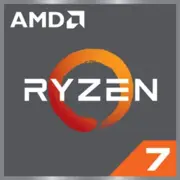AMD Ryzen 7 8700F

The AMD Ryzen 7 8700F processor is a powerhouse for desktop computing, offering impressive performance and efficiency. With a total of 8 cores and 16 threads, this processor is capable of handling heavy workloads and multitasking with ease. The 4.1 GHz performance-core base frequency ensures snappy responsiveness for everyday tasks, while the max turbo frequency of 5 GHz provides the extra burst of speed when needed.
The 16 MB L3 cache further enhances the processor's ability to handle large amounts of data quickly and efficiently, making it ideal for content creation, gaming, and other demanding applications. Despite its impressive performance, the Ryzen 7 8700F maintains a TDP of just 65 W, meaning it runs cool and quiet while delivering exceptional power efficiency.
Overall, the AMD Ryzen 7 8700F is a top-tier processor that delivers on all fronts – performance, efficiency, and value. Whether you're a professional content creator, a hardcore gamer, or a power user in need of a reliable and capable CPU, the Ryzen 7 8700F is definitely worth considering for your next desktop build.
Basic
Label Name
AMD
Platform
Desktop
Launch Date
April 2024
Model Name
?
The Intel processor number is just one of several factors - along with processor brand, system configurations, and system-level benchmarks - to be considered when choosing the right processor for your computing needs.
Ryzen 7 8700F
Code Name
Phoenix
Foundry
TSMC
Generation
Ryzen 7 (Zen 4 (Phoenix))
CPU Specifications
Total Cores
?
Cores is a hardware term that describes the number of independent central processing units in a single computing component (die or chip).
8
Total Threads
?
Where applicable, Intel® Hyper-Threading Technology is only available on Performance-cores.
16
Performance-core Base Frequency
4.1 GHz
Performance-core Max Turbo Frequency
?
Maximum P-core turbo frequency derived from Intel® Turbo Boost Technology.
5 GHz
L1 Cache
64 KB per core
L2 Cache
1 MB per core
L3 Cache
16 MB shared
Unlocked Multiplier
Yes
Multiplier
41.0
Bus Frequency
100MHz
CPU Socket
?
The socket is the component that provides the mechanical and electrical connections between the processor and motherboard.
AMD Socket AM5
Technology
?
Lithography refers to the semiconductor technology used to manufacture an integrated circuit, and is reported in nanometer (nm), indicative of the size of features built on the semiconductor.
4 nm
TDP
65 W
PCIe Version
?
PCI Express is a high-speed serial computer expansion bus standard used for connecting high-speed components, replacing older standards such as AGP, PCI, and PCI-X. It has gone through multiple revisions and improvements since its initial release. PCIe 1.0 was first introduced in 2002, and in order to meet the growing demand for higher bandwidth, subsequent versions have been released over time.
4
Transistor Count
25 billions
Memory Specifications
Memory Type
?
Intel® processors come in four different types: Single Channel, Dual Channel, Triple Channel, and Flex Mode. Maximum supported memory speed may be lower when populating multiple DIMMs per channel on products that support multiple memory channels.
DDR5-5200
Memory Channels
?
The number of memory channels refers to the bandwidth operation for real world application.
2
ECC Memory Support
No
GPU Specifications
Integrated Graphics Model
?
An integrated GPU refers to the graphics core that is integrated into the CPU processor. Leveraging the processor's powerful computational capabilities and intelligent power efficiency management, it delivers outstanding graphics performance and a smooth application experience at a lower power consumption.
N/A
Miscellaneous
PCIe Lanes
20
Benchmarks
Geekbench 6
Single Core
Score
2733
Geekbench 6
Multi Core
Score
14546
Passmark CPU
Single Core
Score
3907
Passmark CPU
Multi Core
Score
31170
Compared to Other CPU
Geekbench 6 Single Core
Geekbench 6 Multi Core
Passmark CPU Single Core
Passmark CPU Multi Core
Share in social media
Or Link To Us
<a href="https://cputronic.com/en/cpu/amd-ryzen-7-8700f" target="_blank">AMD Ryzen 7 8700F</a>